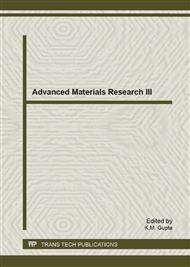p.307
p.312
p.316
p.324
p.331
p.336
p.340
p.347
p.352
Estimation of Elastic Modulus of Dielectric Elastomer Materials Using Mooney-Rivlin and Ogden Models
Abstract:
Elastomers have low elastic modulus, high specific energy density, light weight, high dielectric constant and high electrical breakdown strength. Due to these properties, elastomers are currently recognized as the future materials for actuator technology and actuators based on these materials are known as dielectric elastomer actuators (DEA). Based on Maxwell stress principle, these actuators transform electric energy directly into mechanical work. Modeling large actuation of this material depends on accurate estimation of E-modulus which varies with strain. In this work, E-modulus values at different strain are estimated based Mooney-Rivlin & Ogden Models. The model predicted values of E-modulus are compared with experimentally estimated values of E-modulus and found to be in good agreement.
Info:
Periodical:
Pages:
331-335
Citation:
Online since:
April 2013
Authors:
Price:
Сopyright:
© 2013 Trans Tech Publications Ltd. All Rights Reserved
Share:
Citation:


